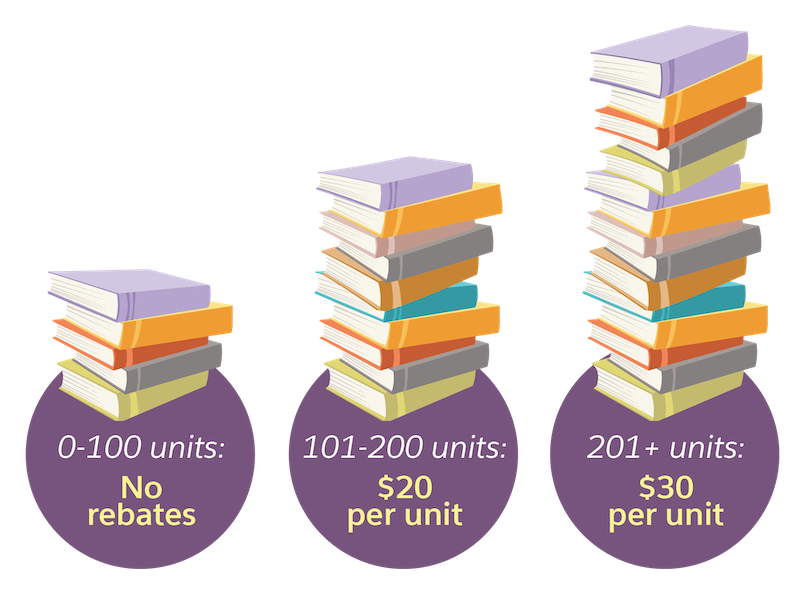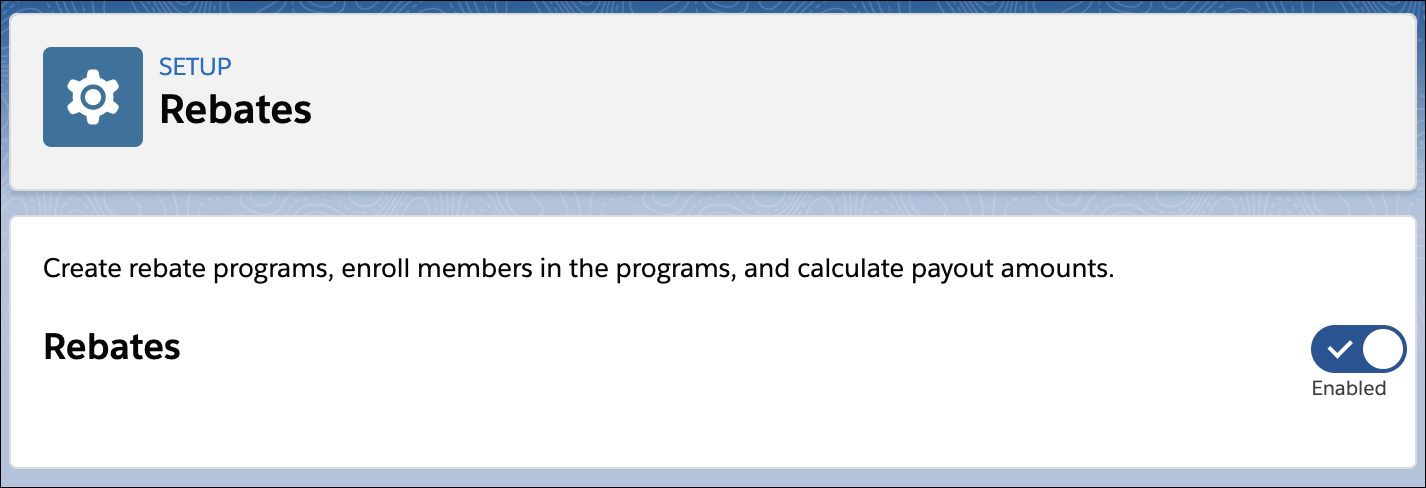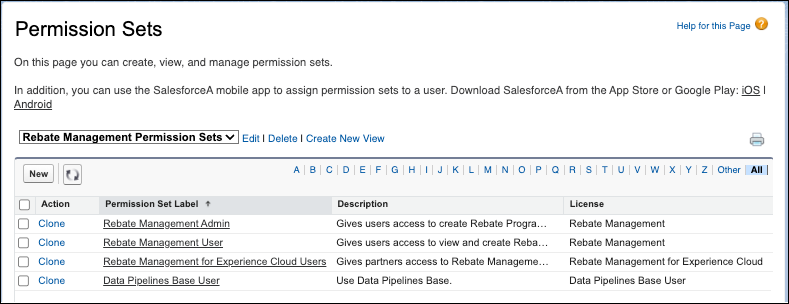Get Started with Rebate Management
Learning Objectives
After completing this unit, you’ll be able to:
- Explain how rebates work as incentives for partners and customers.
- List common challenges that companies face with rebate calculations and payouts.
- List common rebate types.
- Enable Rebate Management.
- Provide users permissions and access to features.
Motivating Your Partners
Companies use rebates to encourage dealers, distributors, and other partners to buy more. Rebates can help grow a business and improve brand loyalty.
Rebates are payouts given to partners, distributors, or customers after the sale of the product if they achieve a specific goal based on sales volume, revenue, or growth. Rebates are different from traditional reward systems like discounts, which are offered up front at the time of sale and simply reduce the list price of the product. Low list prices can affect customer perception of a product’s quality and discourage them from buying. With rebates, you reward your partners for selling your products and encourage them to repeat business with you.
Here are a couple ways companies use rebates to increase their profits.
- Influence channel purchasing behavior and market share.
- Analyze and invest in the best-yielding rebate programs.
But it’s not easy to design effective rebate programs and calculate accruals and payouts. You need to collaborate with many different teams, including sales, finance, partners, rebate program managers, marketing personnel, and business analysts. Let’s see how Rayler Parts, a global leader in the manufacturing industry, deals with the situation.
Meet Rayler Parts and Meridian Partners
Meridian Partners is a key distributor of heavy industrial equipment for Rayler Parts in the Asia-Pacific (APAC) region. Rishi Chatterjee, the rebate program manager at Rayler Parts, plans to design an effective rebate program that benefits everyone. He’s in talks with Mahira Zainab, a trusted member at Meridian Partners, and Zac Mehmood, the VP of APAC sales at Rayler Parts.
There’s hardly any collaboration between account managers at Rayler Parts and partner distributors at Meridian Partners, and calculating rebate payouts is complicated and error-prone. These factors are leading to high overhead costs and a loss of enthusiasm among partners.
Types of Rebates
Rebate Management is versatile and supports volume-based, revenue-based, growth-based, flat, and custom rebate types. Rishi asks Mahira and Mehmood for details about how they want to design the rebate program and its incentives.
They discuss the Annual Rebates Program for APAC, a new program that Mahira and Mehmood have been working on. For this program, they decide to give channel distributors rebates based on the quantity or volume they sell. Volume-based rebates promote higher order volumes and protect the vendor from buyers who overpromise during purchase-price negotiations. Buyers earn rebates only when they reach the volume-based turnover targets.
In this program, partners get incentives only if they sell hammers and trenching buckets through the ecommerce sales channel.

Here’s the tiered structure of incentives that partners receive.
- 0–100 units = no rebates
- 101–200 units = $20 rebate per unit
- +201 = $30 rebate per unit
Mahira and Rishi decide to offer monthly payouts for volume-based rebates.
Challenges and Solutions
Rishi knows the current system that handles rebate calculations and processes payouts is inadequate. He prepares a report that outlines the challenges Rayler Parts currently faces and some potential solutions.
Challenge |
Proposed Solution |
|---|---|
Rebate calculations for accruals and payouts are complex and held in disconnected spreadsheets and enterprise resource planning (ERP) solutions. |
An easy-to-set-up system that allows seamless integration of data right from member details to payout amounts and automates rebate calculations. A way to calculate payouts monthly while accruing more frequently so that accurate accruals go to internal systems. |
Setting up programs, collecting direct sales data for rebate eligibility, and reconciling the data with submitted claims are labor-intensive and prone to error. |
A way to take direct sales orders as transaction inputs. The option to create customized transaction records with details such as region, product category, invoice number, and so on. |
There’s no flexibility to create nuanced rebate programs with multiple eligibility criteria, payouts per transaction, tiered benefits, and other customizations. |
The ability to create flexible and extensible rebate programs that can be triggered by rule-based processes and are based on incentives like growth, volume, and revenue. |
Partners struggle to find clear communication on payout amounts, timelines, and the rebate programs they’re enrolled in. |
An online portal where partners can review rebate programs, payout amounts, and timelines. |
Manual submission of claims and transactions doesn’t allow early tracing of inaccuracies and slows down the process. |
A system to detect common errors in claim submission files so partners can correct them and share updated records. |
There’s no single view where rebate program managers and account managers can see the payouts and rebate details for a specific account. |
A unified view for rebate program managers and account managers where they can see program details and payout amounts and transparently collaborate on program-structure specifications. |
Approval chains aren’t in place to audit payout calculations and rebate adjustments. |
A way for supervisors to approve rebate programs, associated benefits, and eligibility structures and for account managers to adjust payout amounts. |
While working on a contract or quote, sales reps can’t see which rebates a member is eligible for and which ones they already receive. |
A unified view of the contextual rebate information associated with an account, opportunity, quote, or order. |
Rishi contacts Cindy, the Salesforce admin at Rayler parts, and shares his report with her. Cindy meets a Salesforce account executive for Rayler Parts to understand if there’s a solution that can help them.
Cindy is in luck! The Salesforce Rebate Management app ensures transparency in program performance, automates review processes and payout calculations, improves collaboration, and reduces margin leakage. Cindy gets ready to configure Rebate Management for Rayler Parts.
Take a look at this short video to see what Salesforce Rebate Management can offer you.
Want to Get Hands-On with Rebate Management?
In this module, we show you the steps to set up and manage rebate programs with Rebate Management. We don’t have any hands-on challenges in this module, but if you want to practice and try out the steps, you need a special Developer Edition org that contains Rebate Management and our sample data. A regular Trailhead Playground doesn’t have Rebate Management or our sample data. Here’s how to get the free Developer Edition now.
- Sign up for a free Developer Edition org with Rebate Management.
- Fill out the form.
- For Email, enter an active email address.
- For Username, enter a username that looks like an email address and is unique, but it doesn't need to be a valid email account (for example, yourname@test.com).
- After you fill out the form, click Sign me up. A confirmation message appears.
- When you receive the activation email (this might take a few minutes), open it and click Verify Account.
- Complete your registration by setting your password and challenge question. Tip: Write down your username, password, and login URL for easy access later.
- You are logged in to your Developer Edition.
Unlocking the Powers
In this module, we assume you’re a Rebate Management administrator or a rebate program manager with the proper permissions to configure and manage rebate programs and calculations. If you’re not an administrator for Rebate Management, that’s OK. Read along to learn how your administrator would take the steps in a production org. Don't try to follow these steps in your Trailhead Playground. Rebate Management isn’t available in the Trailhead Playground.
To create rebate programs and calculate payouts, Cindy must first enable Rebate Management in the Rayler Parts org. This gives Rayler Parts access to all rebate management objects.
- Click
 , and select Setup.
, and select Setup.
- In the Quick Find box, enter Rebates.
- Click Rebates, and turn on the feature.

Rebate Management comes with a few powerful features: Salesforce Flows, Data Processing Engine, and Batch Management. They’re crucial for rebate calculation, and each contain useful predefined templates. Cindy can view all the templates in the org.
You learn more about the templates in later units. The next step is to provide the required permissions to users in Rayler Parts.
Permissions and Access
Cindy must provide rebate program managers access to rebate management features. She also needs to give partners the required permissions to upload transactions and view payouts through the Experience Cloud portal. This screen shows the permission sets available for rebate management.

The permission sets include:
- Rebate Management Admin
- Rebate Management User
- Rebate Management for Experience Cloud Users
- Data Pipelines Base User
To learn more about which permission set to assign to what user, see Assign Permission Sets for Rebate Management.
Resources
- Trailhead: Admin Essentials for Sales Agreements and Account Forecasting
- Salesforce Help: Common Rebate Types
- Salesforce Help: Set Up Rebate Management
- Salesforce Help: Permission Sets
